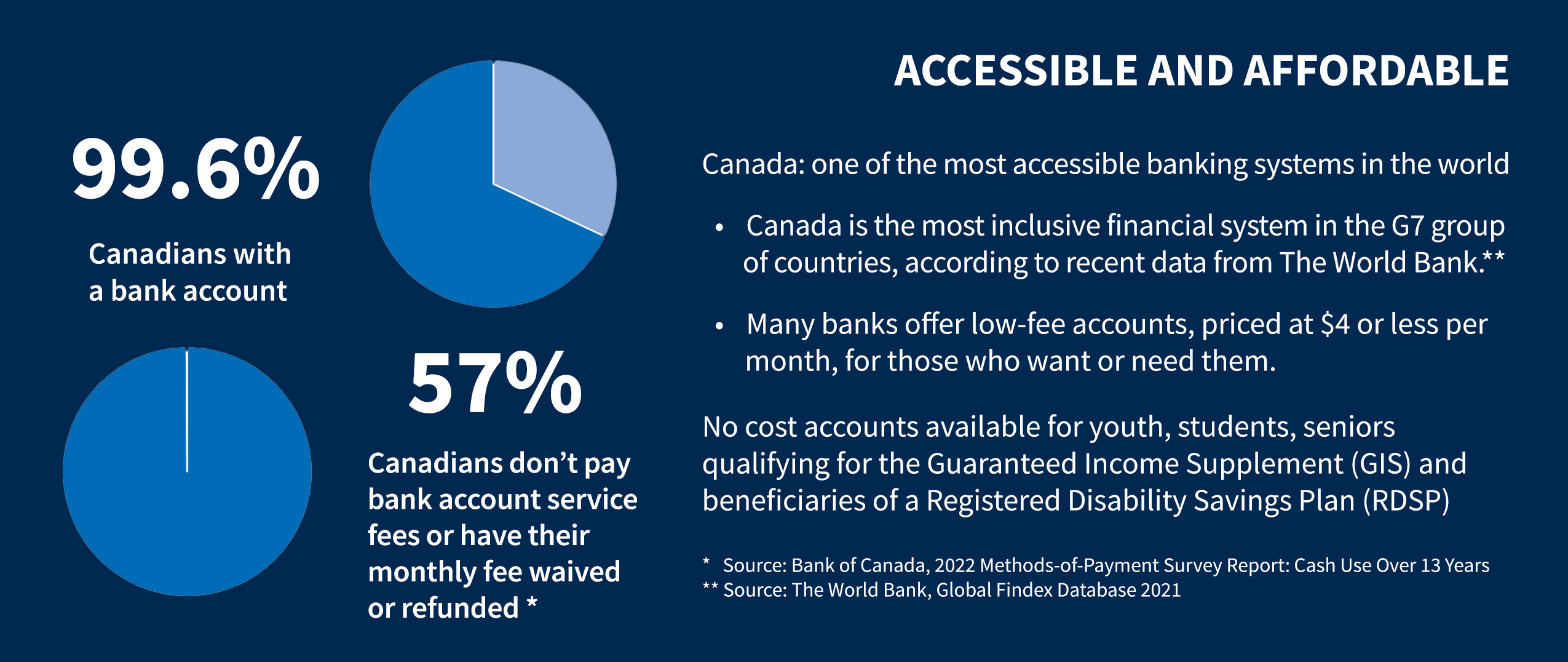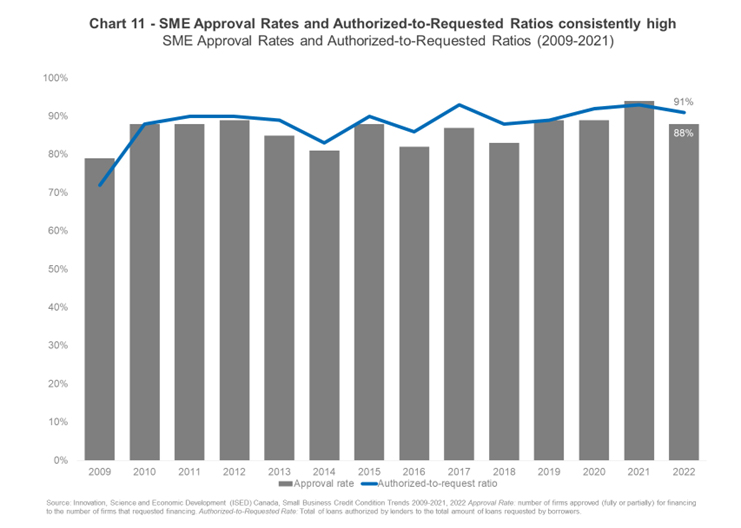Fast Facts
- Abundant choice There are more than 80 domestic and foreign banks operating in Canada with more than 40 offering financial products and services to consumers.
- Accessible and affordable: 99.6 per cent of Canadian adults have an account with a financial institution1
The Bottom Line
Canadian households and businesses enjoy the advantages of a competitive financial services sector that offers accessibility to a diverse range of banking services and providers at affordable value. The entry of new players can enhance these options, therefore it's crucial to establish consistent regulations for all market participants to ensure continued trust and confidence in Canada's secure and stable financial services industry.
Robust competition and market dynamics
Canadian households and businesses continue to benefit from having access to a wide range of affordable financial services in a thriving and highly competitive sector. Canada boasts more than 80 banks which vary in size and business model. They compete against each other and hundreds of credit unions, caisse populaires, government-owned deposit taking and financial institutions, life, health and general insurance companies, investment firms and specialized finance companies, that compete for Canadians’ business. Furthermore, the financial sector is ever-expanding, as large technology platforms with growing access to consumer data and fintech payment services providers, buy-now-pay-later companies, digital currency exchanges, robo-advisors, etc. enter the market.
Canada’s banks are internationally recognized as
well-regulated and Canada is home to one of the world’s most stable financial sectors. Banks provide affordable choice with innovative and reliable products and services and accessibility to customers.
Increased competition driven by technology and its impact
Advancements in technology have revolutionized the financial sector, fostering greater competition among traditional banks, non-bank financial institutions and, increasingly, non-financial firms. These technological innovations have facilitated market entry and scalability, intensifying competition within the sector. To stay competitive, banks are increasingly investing in and integrating technology into their business models to enhance customer experiences. Indeed, banks have invested approximately $120 billion in technology over the past decade.
Technological innovations have reshaped banking experiences, offering consumers enhanced accessibility, security, and convenience. With digital banking platforms and advanced payment solutions, consumers enjoy streamlined financial interactions, contributing to improved satisfaction levels. The proliferation of digital channels indicates a growing preference for tech-driven banking services among Canadians.
Concentration vs. competitive intensity
The structure of Canada’s banking system is similar to that seen in most developed countries – a core of large, national institutions supplemented by a number of smaller institutions that focus on specific regions or products, and a selection of foreign banks offering specialized services. According to the World Bank, the five largest banks account for 85 per cent of commercial bank assets in Canada in 2021, which is almost identical to the OECD average (83 percent). Though this concentration says very little about whether or not competitive intensity is changing nor does it account for the financial services that are provided by non-banks offering
substitutable products and services.
In Canada, the intensity of competition has increased considerably because of digitalization. The transformation of financial products and services from physical to digital has enabled banks, other financial institutions, financial fintech players with new business models as well as large multinational technology platforms with growing access to consumer data to offer products and services from coast to coast without the need of a physical presence in every region. As a result, banks and other competitors can now compete in every market for every consumer in a way that would have been unimaginable in prior eras.
Canadian banks consistently outperform in terms of customer satisfaction and service quality, positioning them favourably on the global stage. Moreover, the sector's stability and consumer confidence underscore its resilience, especially in comparison to global counterparts. Canadians ranked their banks as the most sound in the world for eight straight years and in the top three for eleven straight years after coming out of the Global Financial Crisis.
Accessibility and satisfaction strong

Canadians have a wide variety of options for bank accounts, payments and mortgages. These products and services offer access to the financial system. In Canada, almost all working-age Canadians have an account with a financial institution and 96 per cent of working-age Canadians have a debit card, which is the highest among the G7 countries. Technology has evolved products and services offered over the years, thus increasing the demand for digital payments. In 2008, 55 per cent of all transactions were conducted in either cash or cheque, whereas by 2022, the number has reduced to only 12 per cent.
Supporting the small and mid-size businesses that drive the Canadian economy
For SMEs, access to financing is an important component for conducting business. Canadian financial institutions are supportive of businesses and provide the capacity and tools for businesses to seize growth opportunities and tackle challenges.
Banks have strong ties to SMEs including farmers and other agricultural customers. Banks authorized $1.78 trillion in credit to Canadian businesses as of December 2023. Of that, $286 billion went to small and medium-sized businesses.
According to Statistics Canada, 88 per cent of SME’s debt financing requests were approved in 2022 with the approval rate consistently being above 80 per cent since the GFC. And of those SMEs that were approved for debt financing, the ratio of total funds authorized-to-requested was 93 per cent in 2021, with the funds authorized-to-requested consistently about 80 per cent since the GFC. The average amount authorized has increased for businesses of all sizes, regions and industrial sectors since the GFC (see chart below).

Ensuring consumers are protected
Large multinational technology companies are making inroads into the financial services arena, which was not contemplated by traditional regulatory frameworks. Regulatory requirements should adhere to the principle of “same risks, same rules, same regulations” to ensure that consumers are consistently protected when using any entity engaging in bank-like activities.
The financial sector in Canada experiences heightened competition driven by technological advancements, diverse market players, and evolving consumer preferences. The banking sector is robust and dynamic, offering innovative solutions and fostering consumer trust. As technology continues to shape the industry, maintaining regulatory frameworks that ensure both innovation and consumer protection will be paramount for sustained competitiveness and stability.
To read more about CBA’s recommendation on how to strengthen competition in the financial sector, please click here.
1 World Bank, Global Findex Database 2017: https://globalfindex.worldbank.org/sites/globalfindex/files/2018-04/2017
Findex full report_0.pdf pg. 123